Museum Remix
LGBTQ+ stories
from the University of Cambridge Museums
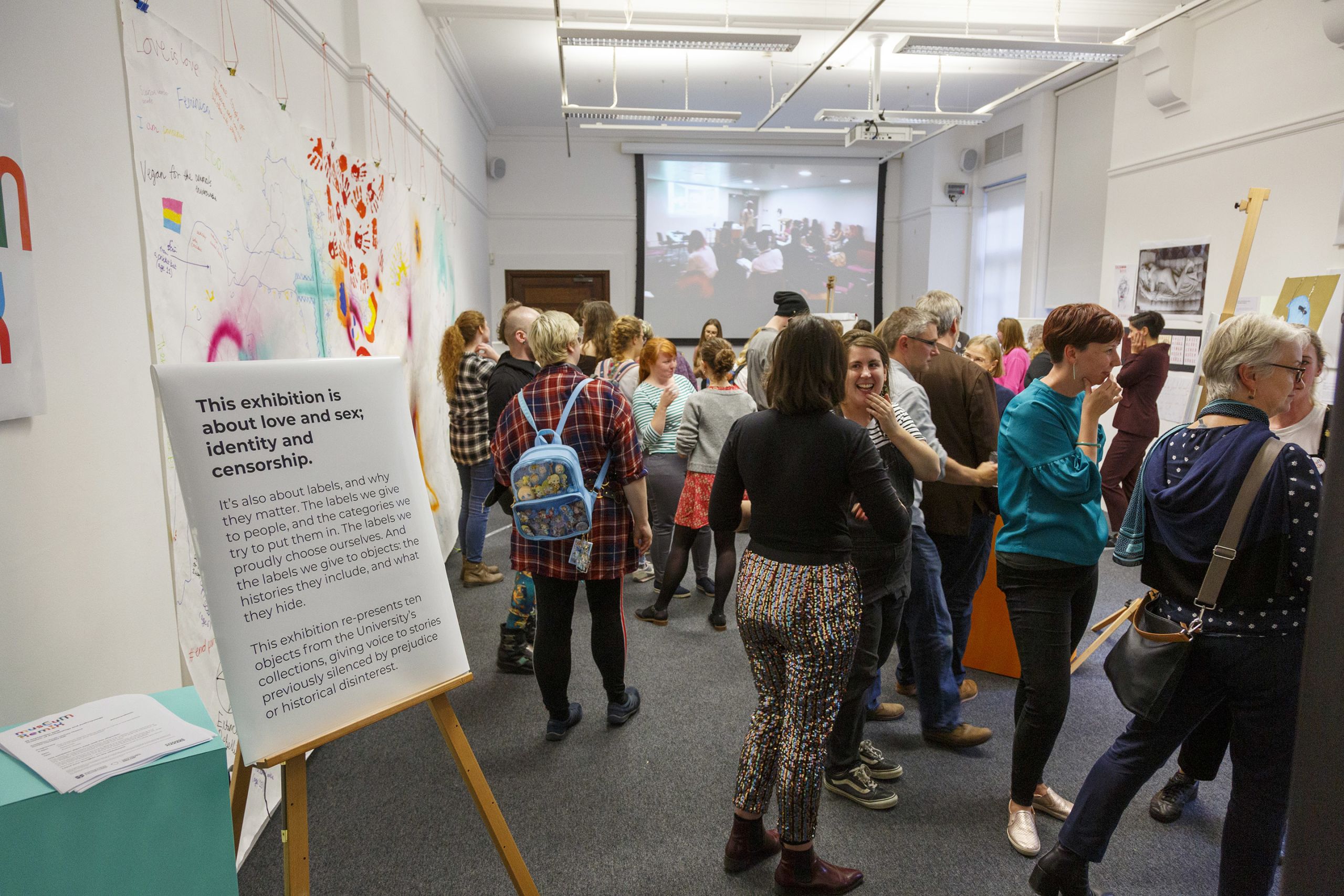
This exhibition is about love and sex; identity and censorship.
It’s also about labels, and why they matter. The labels we give to people, and the categories we try to put them in. The labels we proudly choose ourselves. And the labels we give to objects: the histories they include, and what they hide.
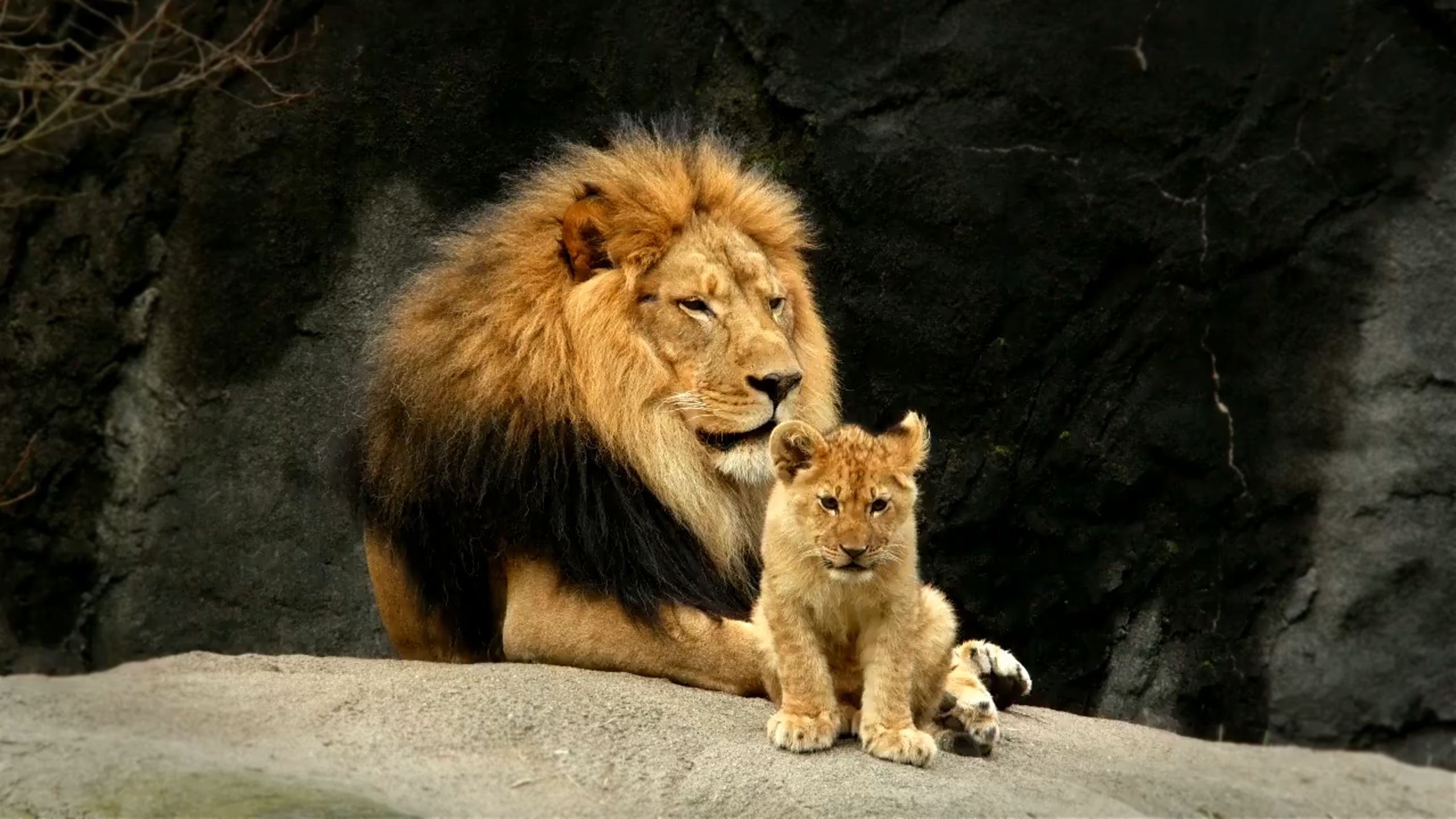
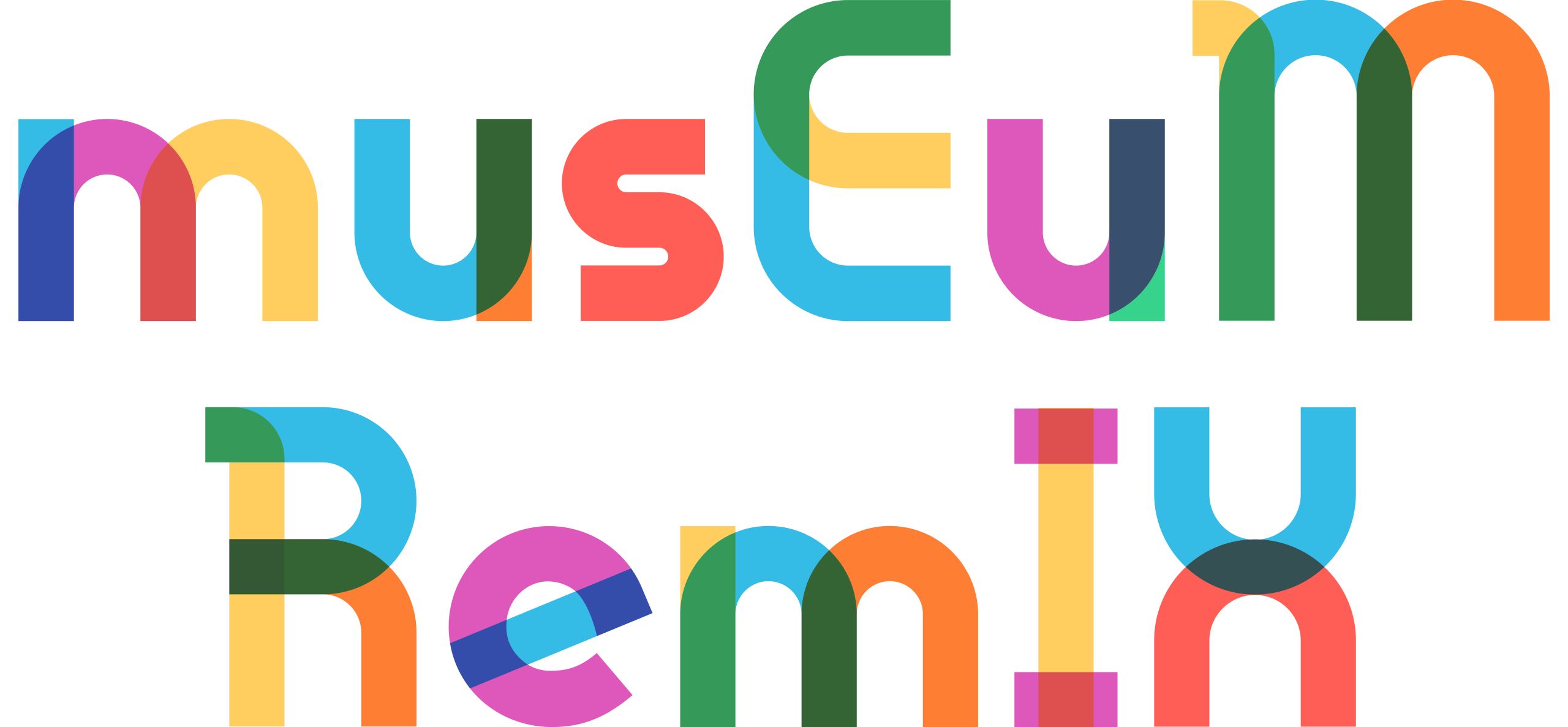
This exhibition re-presents ten objects from the University of Cambridge’s collections, giving voice to stories previously silenced by prejudice or historical disinterest.
It was curated over two days in 2019 by the participants of the Museum Remix workshop. They worked with the stories from Bridging Binaries LGBTQ+ tours and interrogated the collections, produced new artworks, and drafted new labels.
Everything you read from now on is their text.
Love and sex in the animal kingdom are found in a huge diversity of forms.
Humans have assigned labels to animal behaviour and relationships for over a century, forcing diversity into discrete human categories.
Zoological collections use individual specimens to represent whole species. Likewise, not all species are represented equally within displays. This reduces the variety we see in the animal kingdom from which humans can learn.
Bonobos
Sexual behaviour between individuals of the same sex is common amongst bonobos, for whom sex has a variety of functions: as a greeting, to reduce tension and avoid conflicts.
There is less than 1% difference in the DNA of bonobos and humans.
Collection: Museum of Zoology
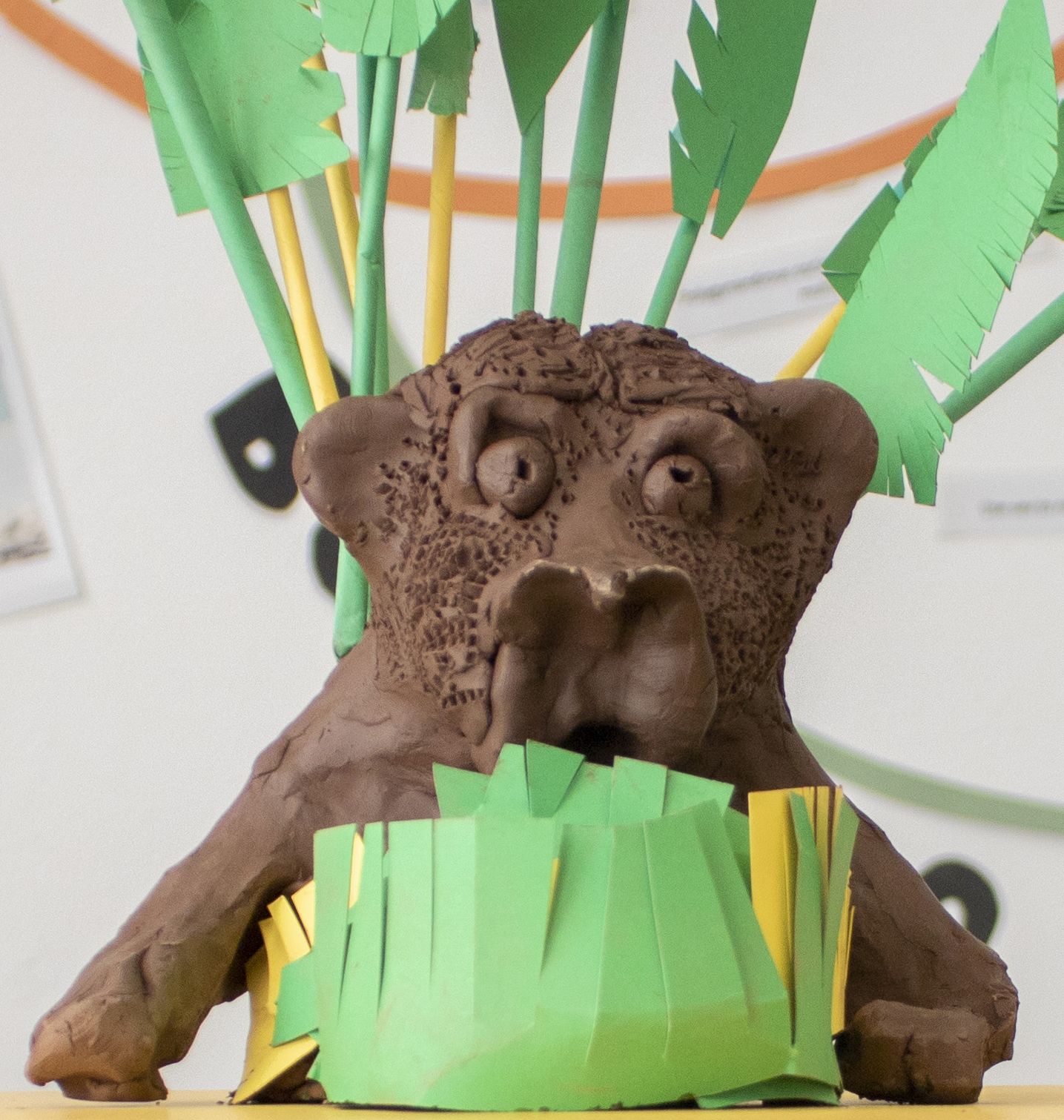
Penguins
On Scott’s Antarctic expedition (1910-12), zoologist George Levick observed sexual behaviour between Adélie penguins of the same sex. He wrote his notes in Greek, only allowing ‘educated gentlemen’ to read them.
Penguins form same-sex pair-bonds, in which they incubate eggs and raise young.
Collection: Museum of Zoology
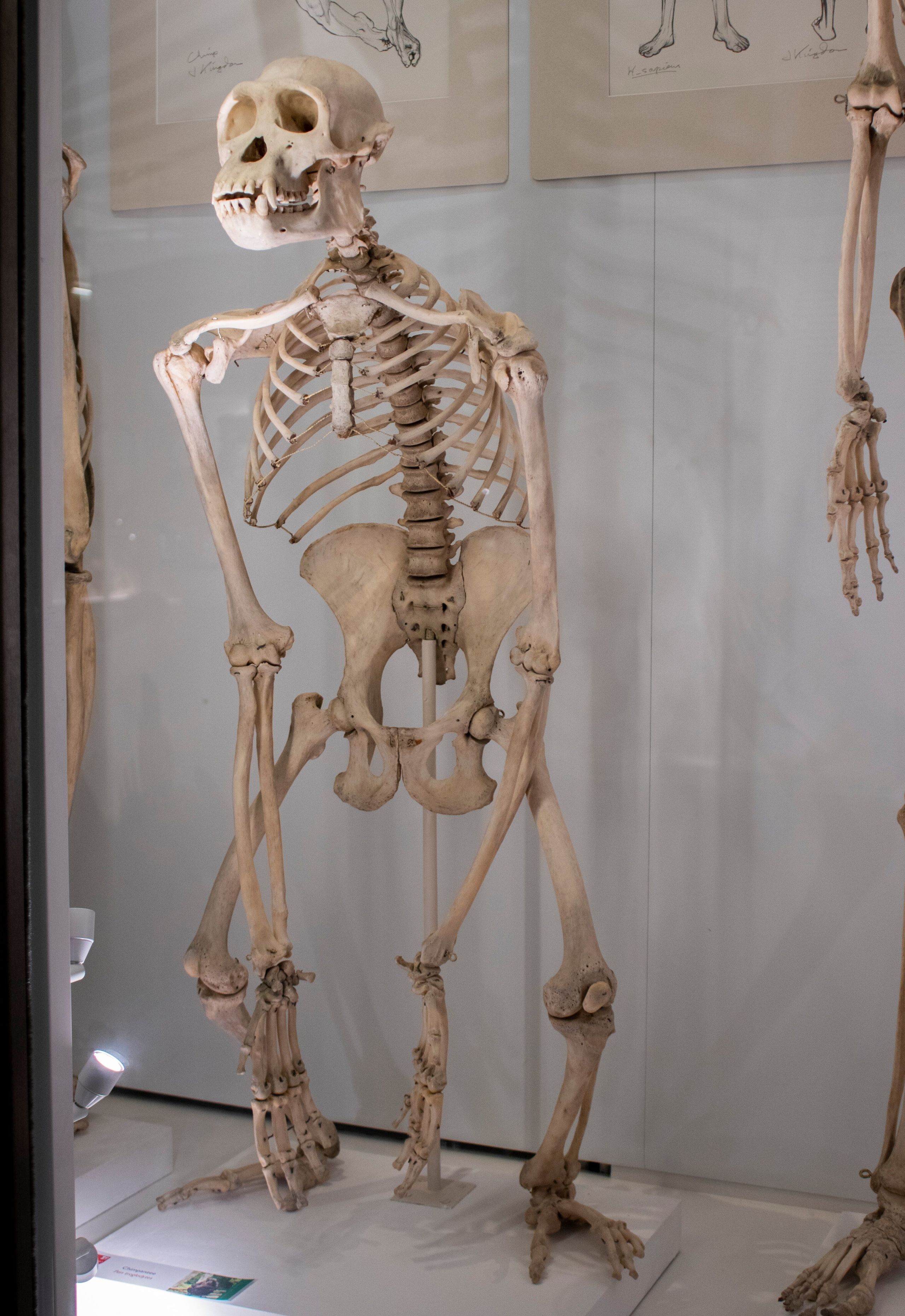
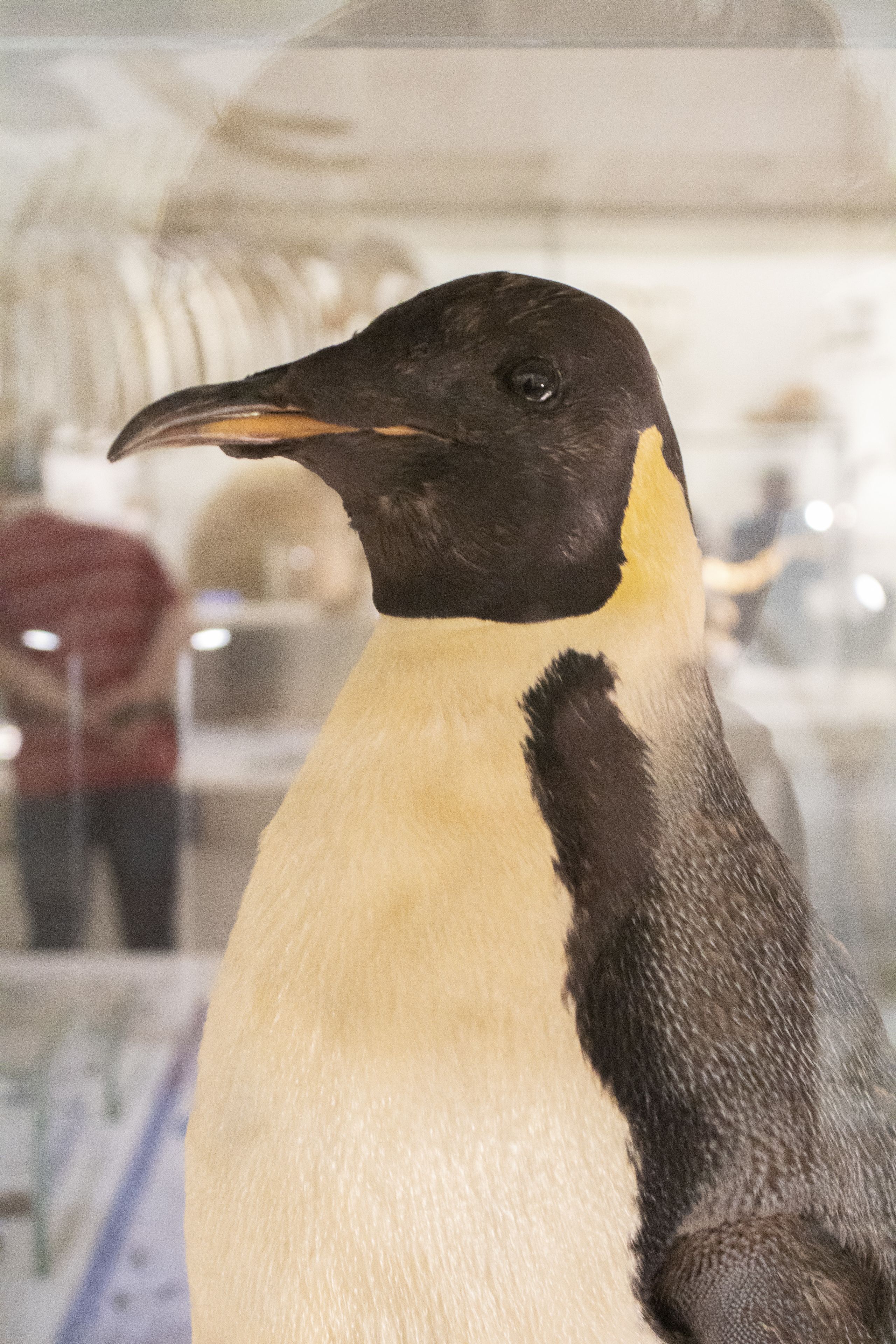
Whose stories become historical fact?
"When as Queen Anne of great renown / Great Britain’s sceptre swayed / Beside the Church she dearly loved / A dirty chambermaid
"O Abigail that was her name / She starched and stitched full well / But how she pierced this royal heart / No mortal man can tell
"However for sweet service done / And causes of great weight / Her royal mistress made her, Oh! / A minister of state
"Her secretary she was not / Because she could not write / But had the conduct and the care / Of some dark deeds at night."
18th century satirical poem.
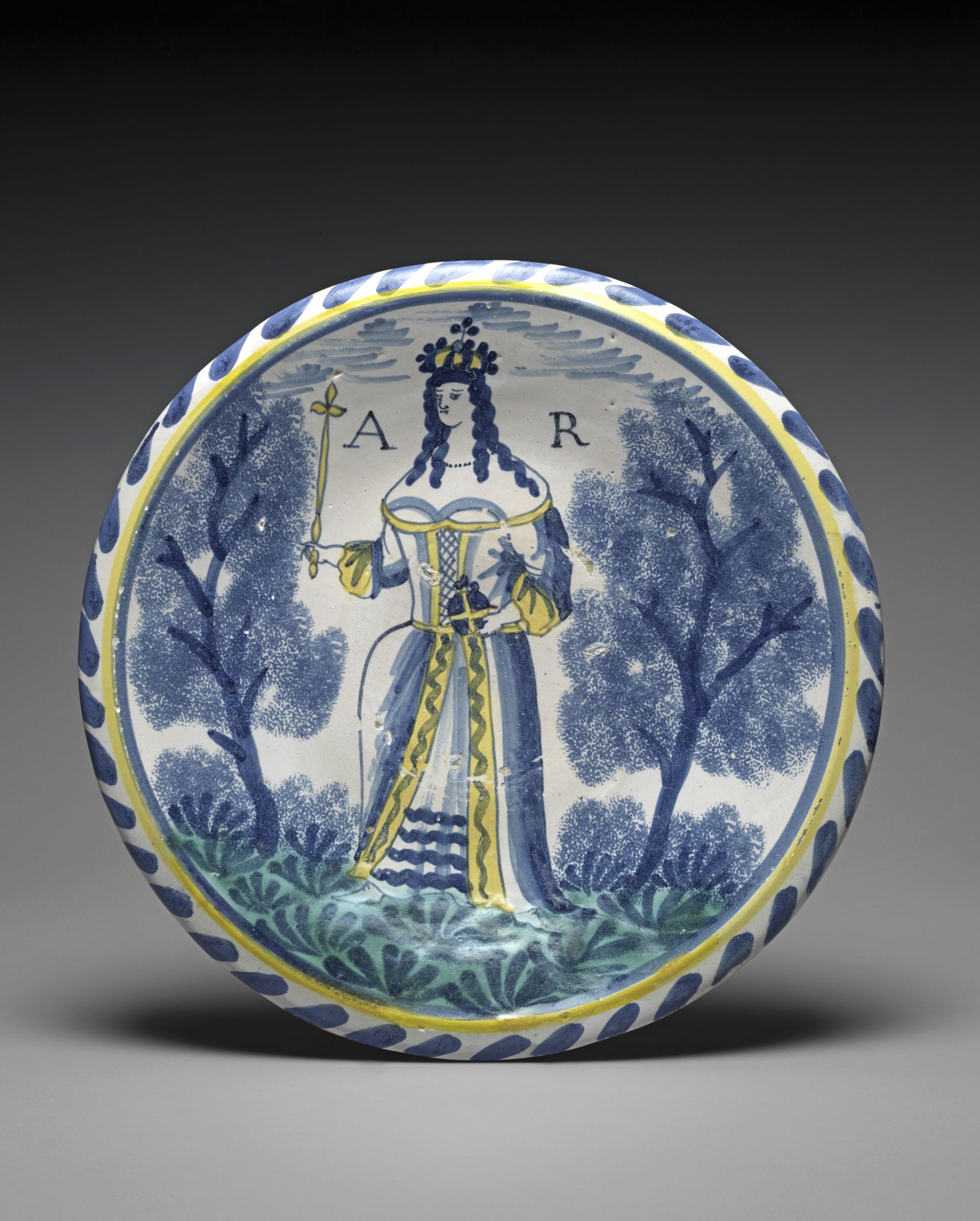
Plate
Queen Anne
Tin-glazed earthware
Anne was written about unfavourably by her former lover Sarah Churchill. These memoirs were remembered as fact long after her death - until recent historians looked into other accounts of her reign.
How do we decide whose stories become historical fact?
Collection: Fitzwilliam Museum
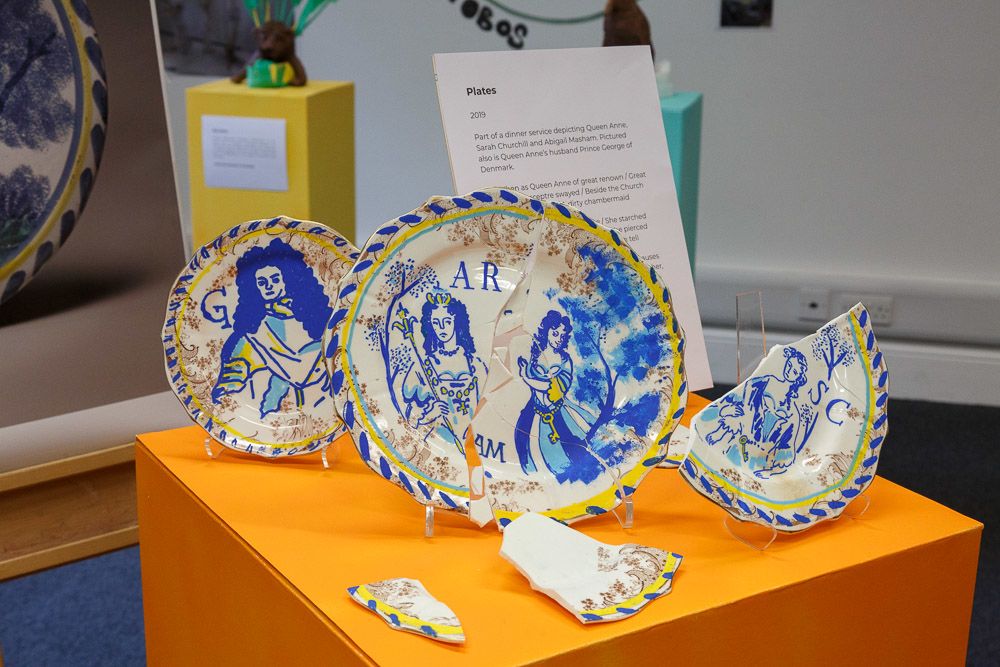
Plates. 2019. Part of a dinner service depicting Queen Anne, Sarah Churchill and Abigail Masham. Pictured also is Queen Anne's husband Prince George of Denmark.
Plates. 2019. Part of a dinner service depicting Queen Anne, Sarah Churchill and Abigail Masham. Pictured also is Queen Anne's husband Prince George of Denmark.
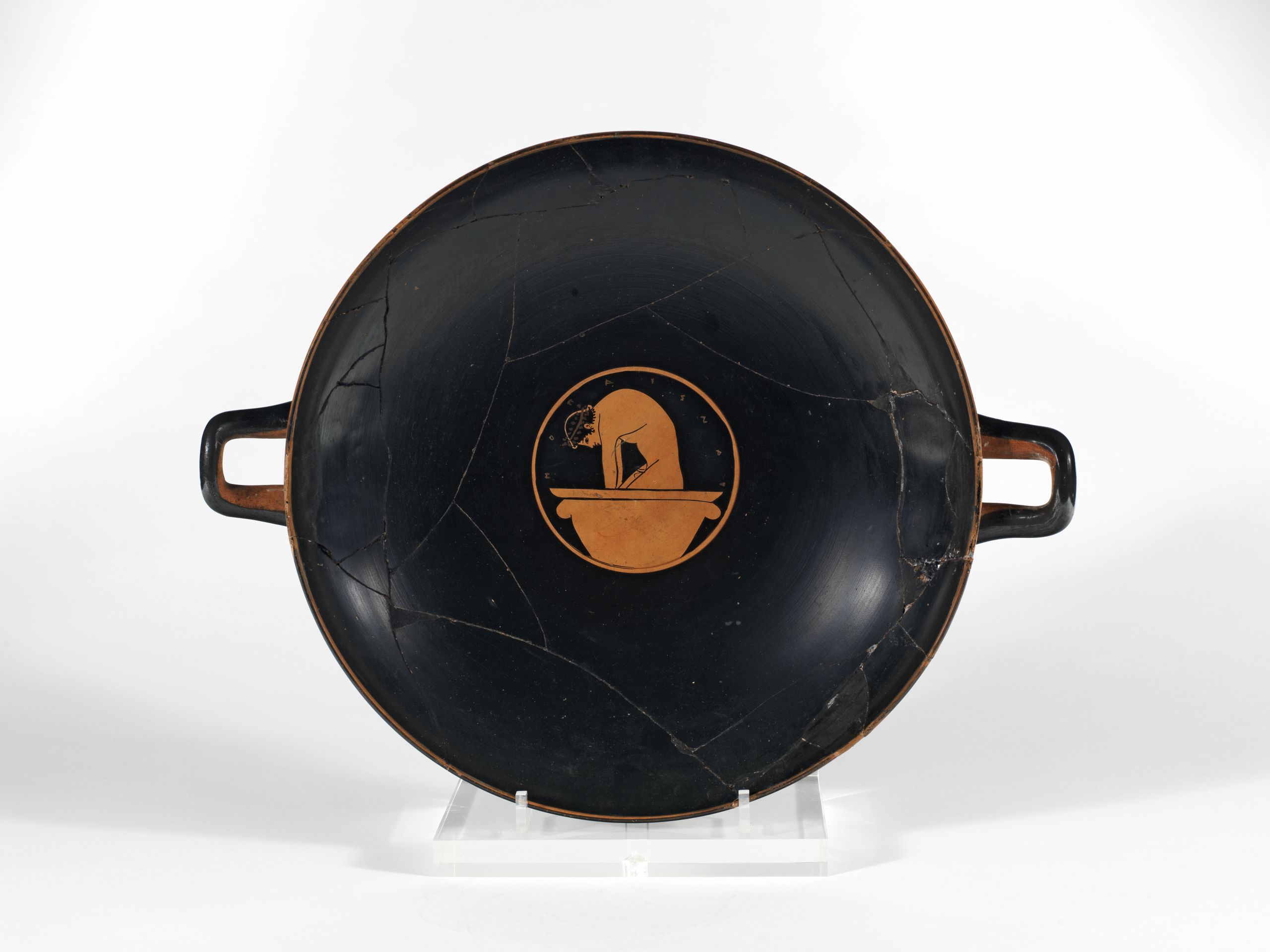
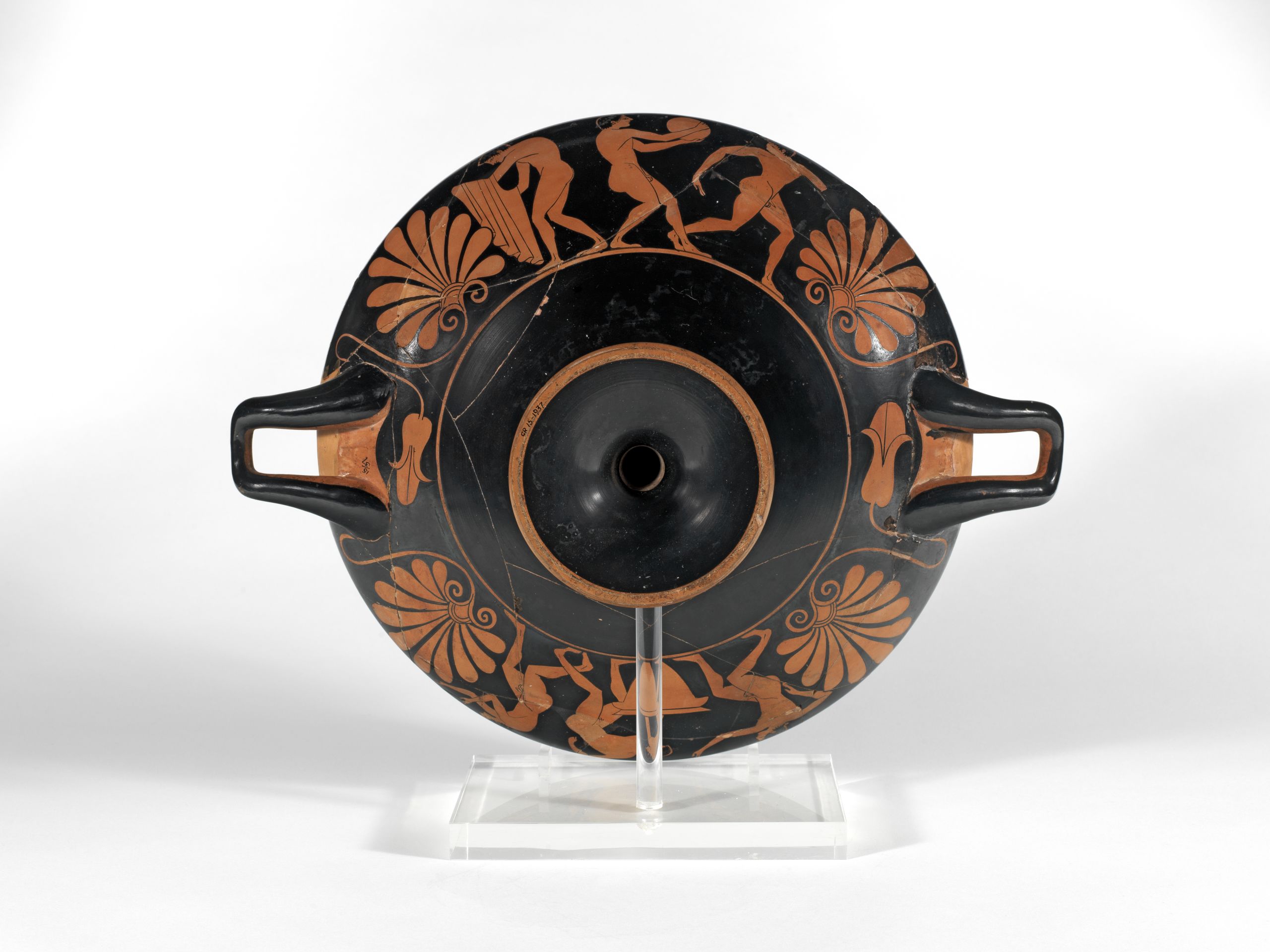
Cup
Interior: Boy inside a bell-krater (bowl for mixing wine)
Exterior: between palmettes, young revellers and young athletes
Inscribed: “The boy, yes, the boy is beautiful.”
Drinking vessels like this were used in symposia, lavish men-only parties in Ancient Greece. What could the paintings on the inside and outside symbolise? What does the inscription tell us about these men’s attitudes to love and beauty?
Collection: Fitzwilliam Museum. Part of the Ricketts & Shannon bequest.
Letter to the Director of the Fitzwilliam Museum
2019
Film, cardboard, gouache, split pins, wire, original text from letters in the Fitzwilliam archive
"Dear Sir,
My friend Lowinsky has asked me to write to you to enclose his request that on the inscriptions attached to the many works of art left by my friends Ricketts and Shannon both their names should appear and not only Shannon's who happened to die latest. The bequest to the Fitzwilliam was in both their wills though each left the whole to the survivor. [...]
Their friendship like their collection was unique and they regarded its designation by their joint names as their monument."
From a letter to the Director by Thomas Sturge Moore, 24 October 1937
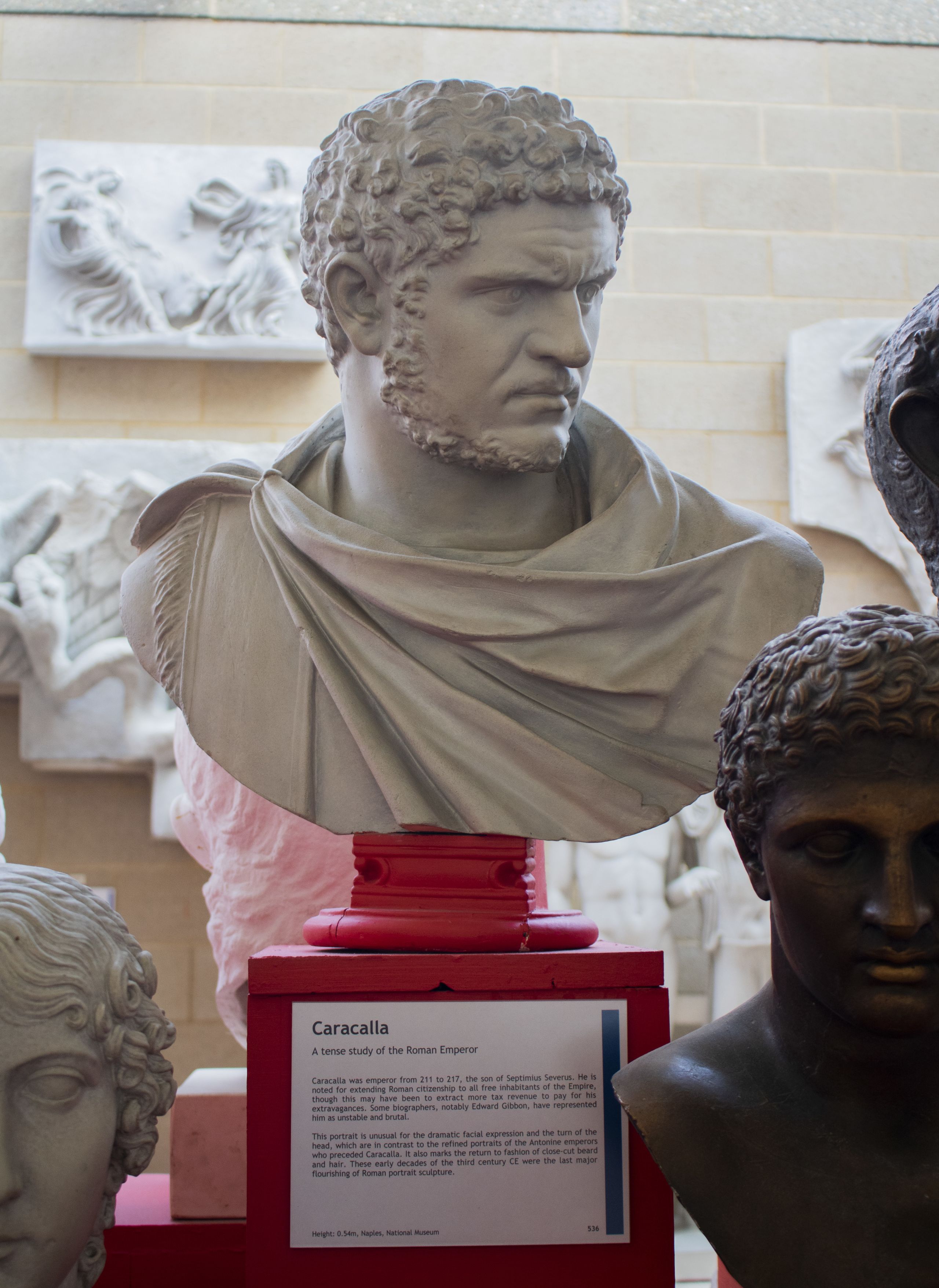
Caracalla
Warlike and brutal, Caracalla was Roman emperor 211-217. The son of powerful black ruler Septimus Severus, he came under attack from contemporaries including Cassius Dio who used sexuality as ammunition.
Sound familiar?
Collection: Museum of Classical Archaeology
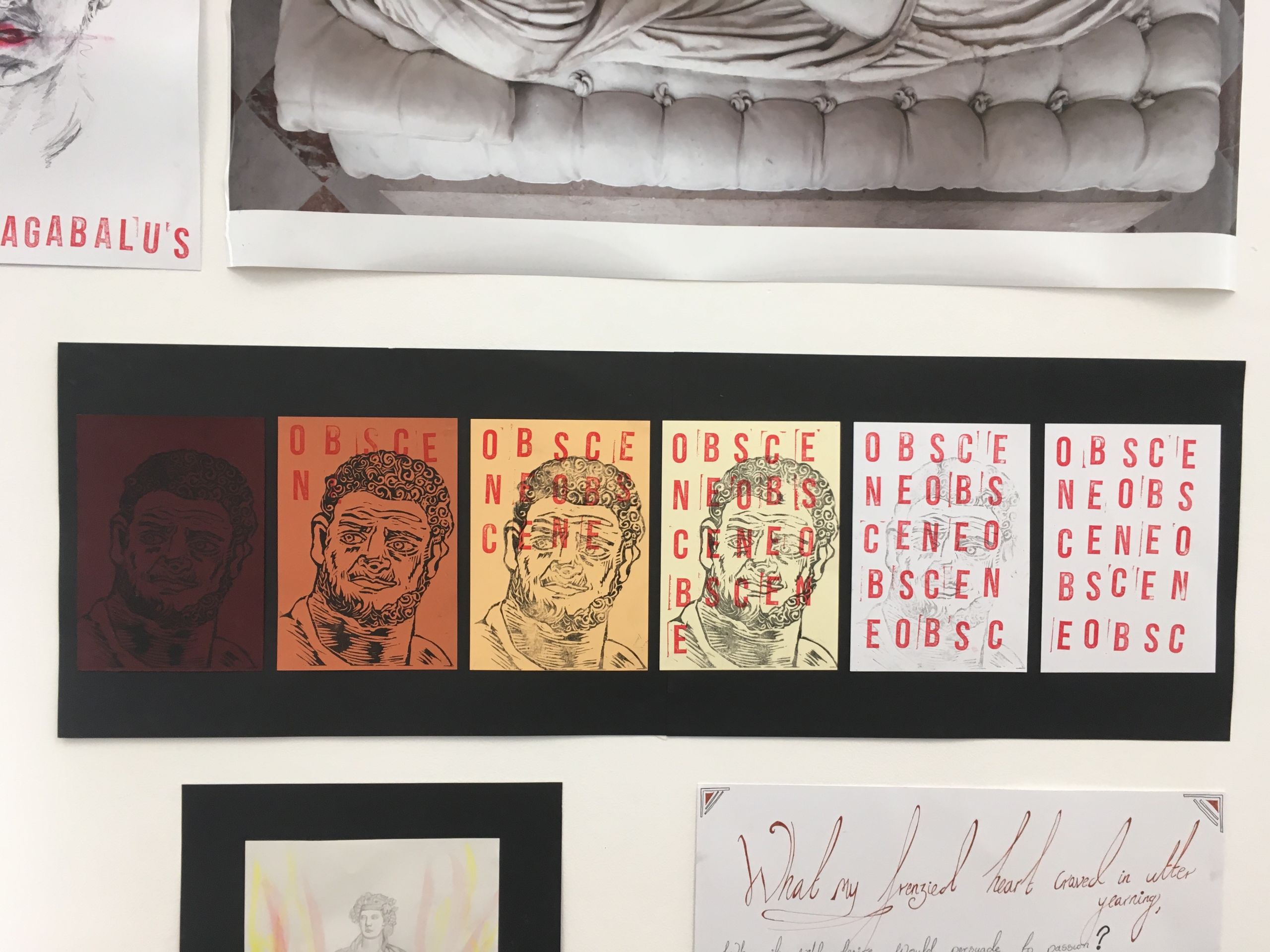
Caracalla (2019). Linocut print on paper.
Caracalla (2019). Linocut print on paper.
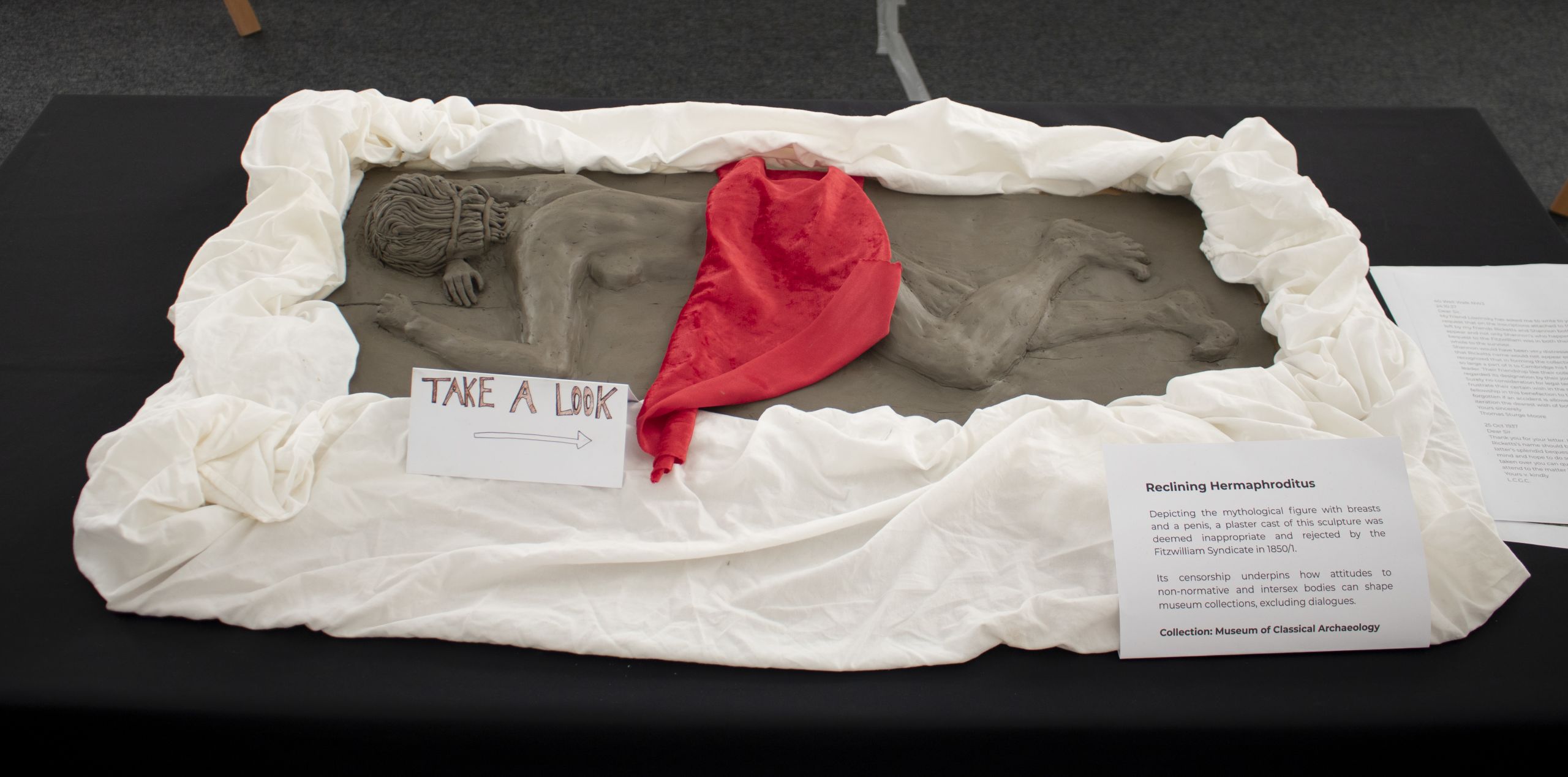
Reclining Hermaphroditus (2019).
Reclining Hermaphroditus (2019).
Reclining Hermaphroditus
2019. Clay, paper, fabric.
Depicting the mythological figure with breasts and a penis, a plaster cast of this classical sculpture was deemed inappropriate and rejected by the Fitzwilliam Museum Syndicate in 1850/1.
Its censorship underpins how attitudes to non-normative and intersex bodies can shape museum collections, excluding dialogues.
Absent from the collection of the Museum of Classical Archaeology
‘Does this make you laugh?’
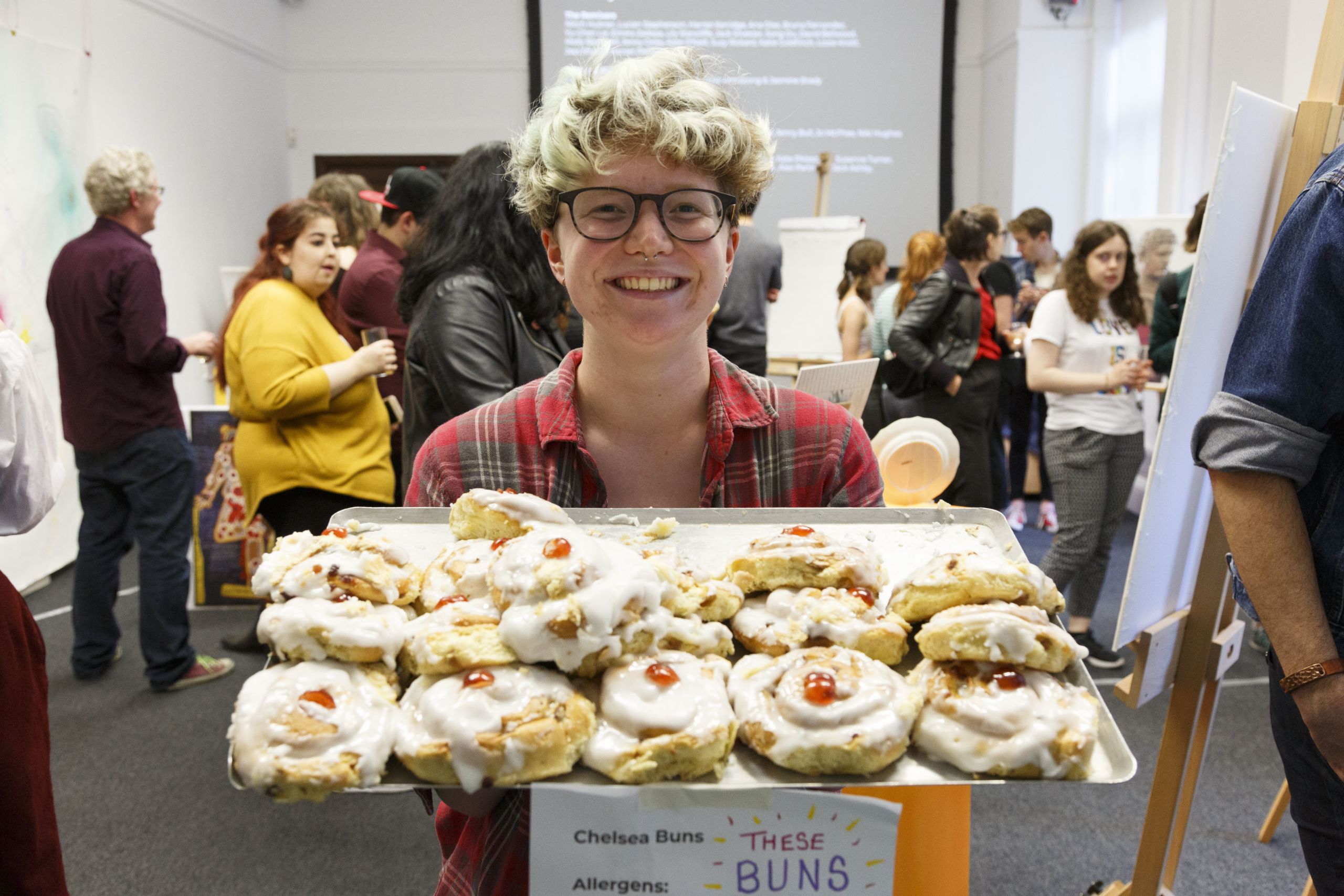
Andakupa
False breasts for the Naven ceremony, Papua New Guinea.
In the West, men with breasts are often an object of humour and taboo. These false breasts, made from coconut shells, are worn by men during the Naven ceremony as part of a ritual reversal of gender roles.
Collection: Museum of Archaeology & Anthropology
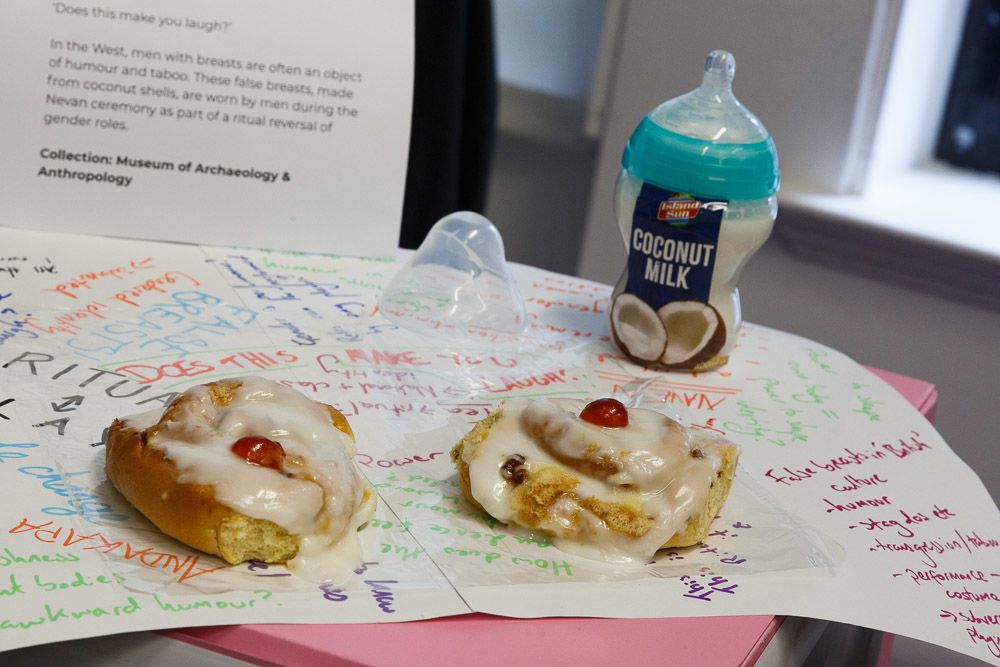
Chelsea buns and coconut milk, displayed on working notes.
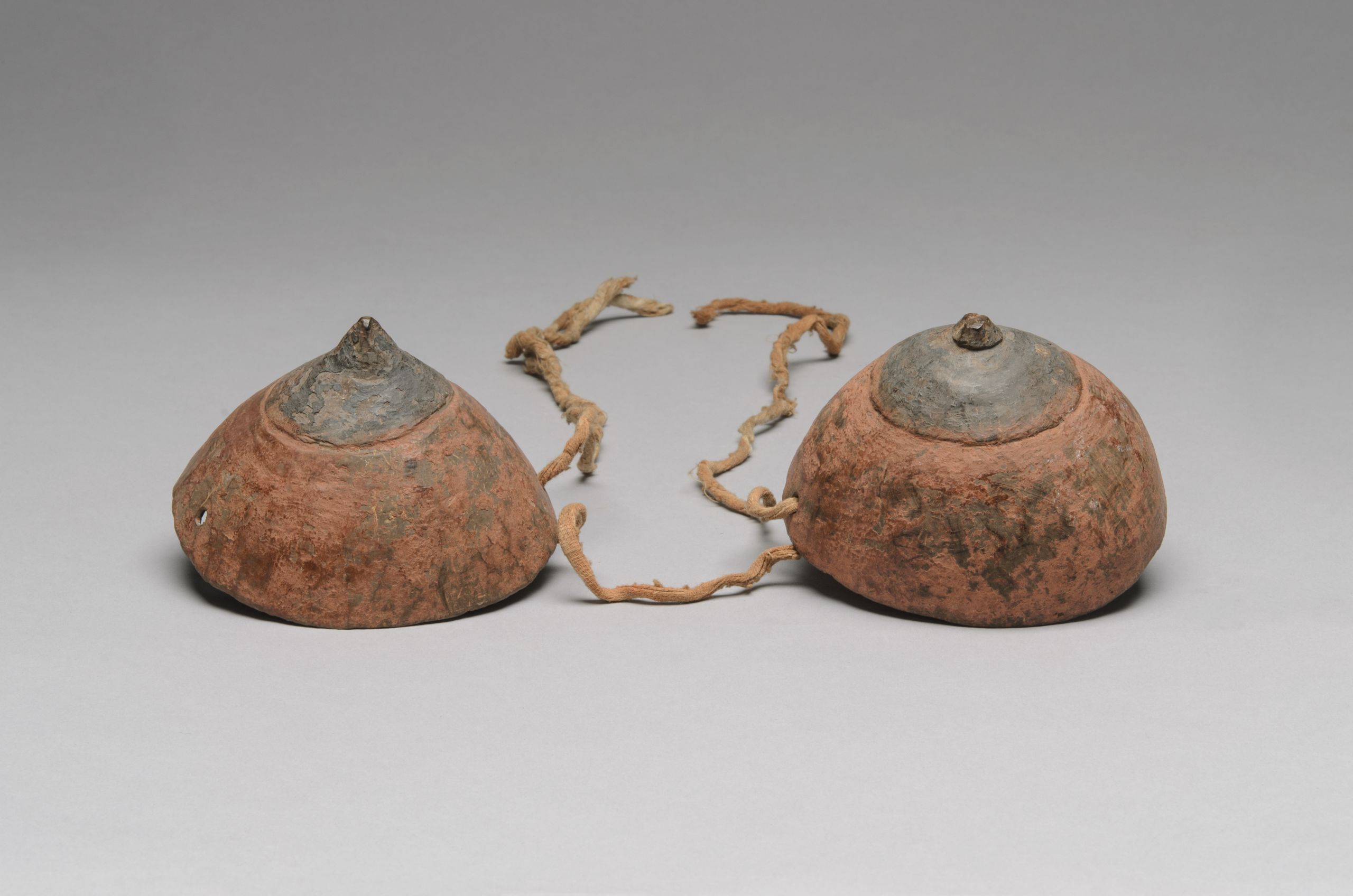
Andakupa. False breasts from the Neuan ceremony, Papua New Guinea.
Andakupa. False breasts from the Neuan ceremony, Papua New Guinea.
Body map
By Nondumiso Hlwele, South Africa, 2003
This self-portrait shows the artist’s body as a ‘museum of life’, demonstrating her experiences living with HIV. In its abstract approach to the body and expression of a fight against stigma, this piece speaks strongly to queer themes.
Collection: Museum of Archaeology & Anthropology
Below: The Museum of Life (2019). Paint, markers, paper.
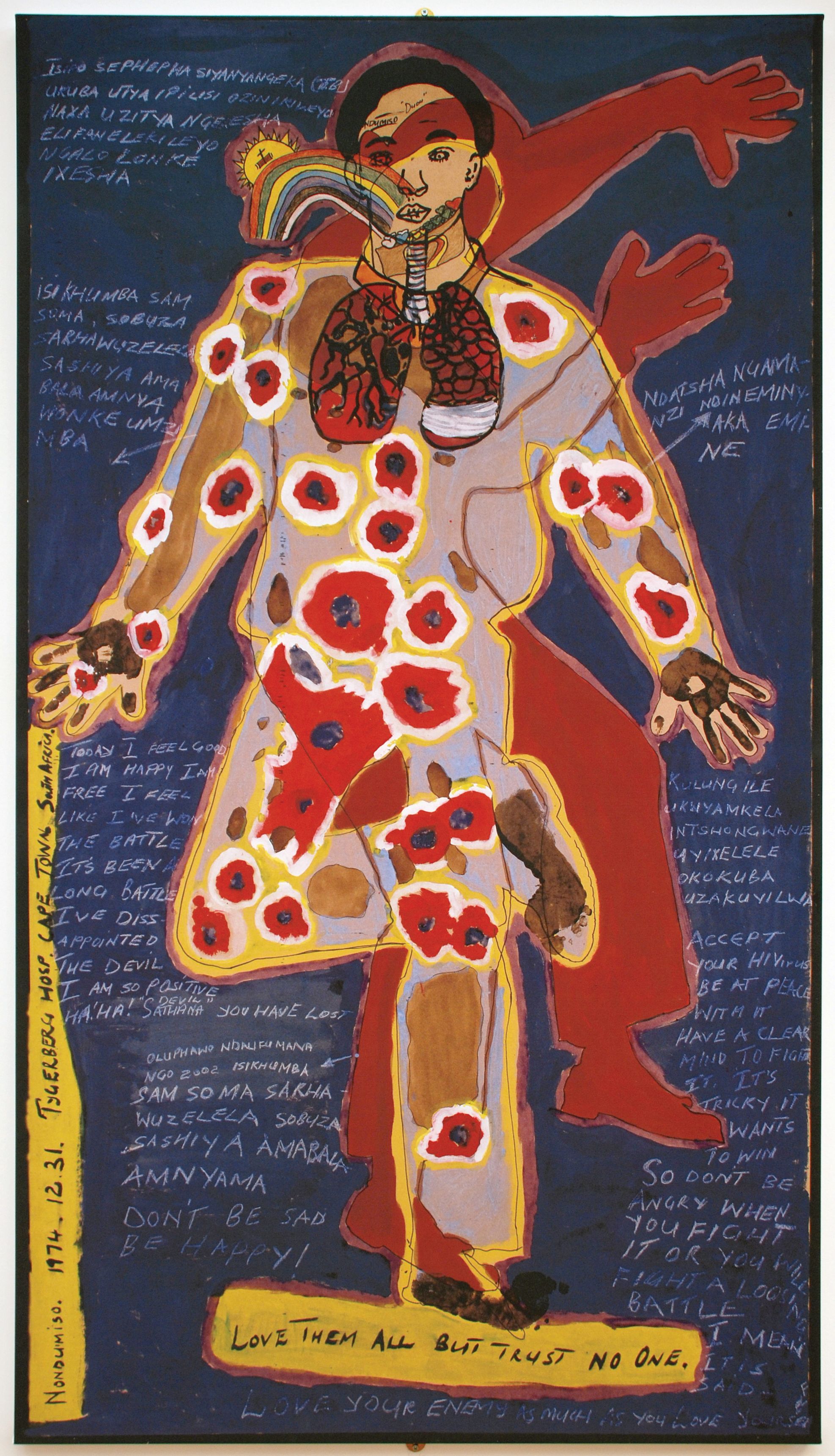
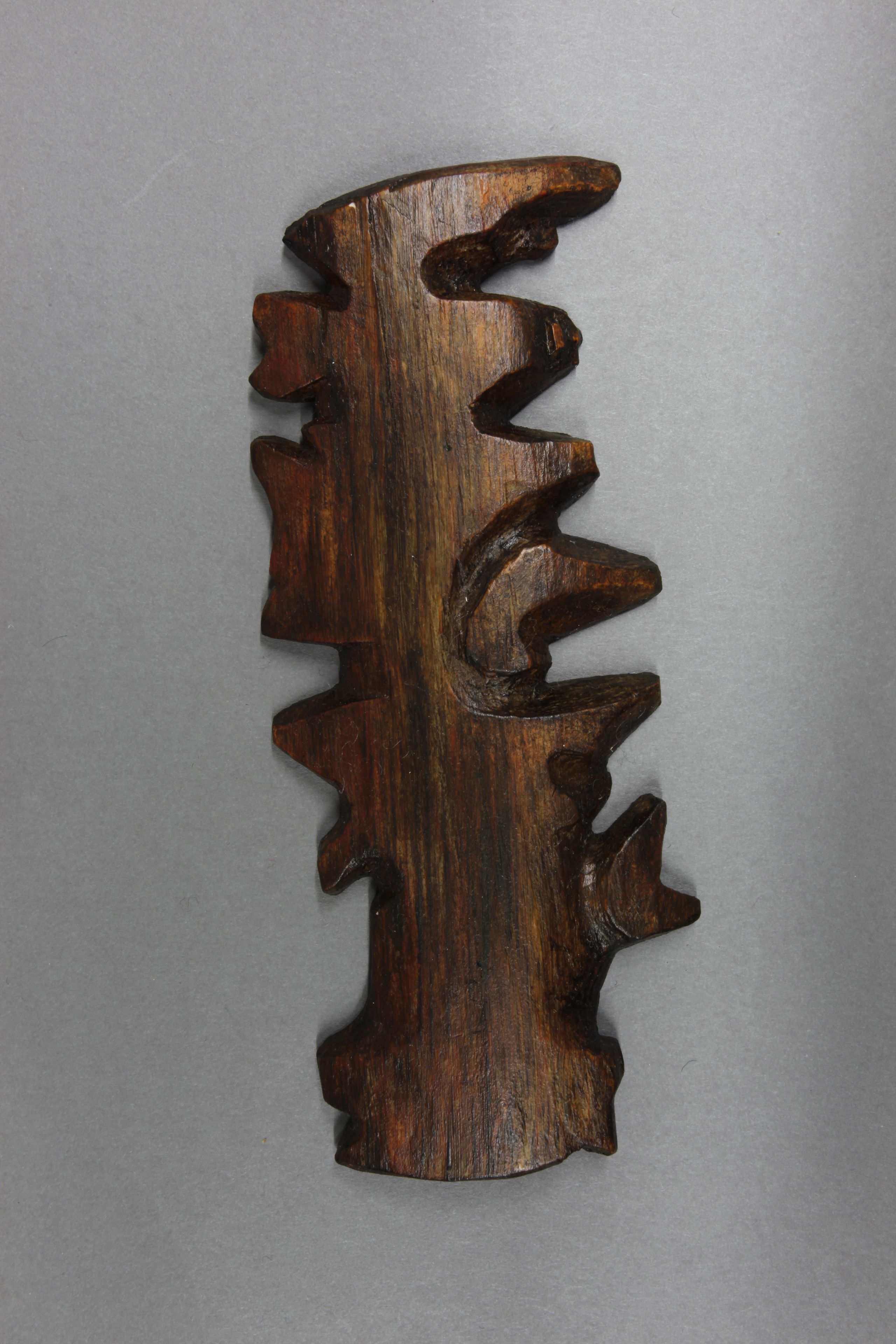
Wooden map
Kalaallit Nunaat, artist unknown, date unknown
Collection: Polar Museum
Displayed with interactive label:
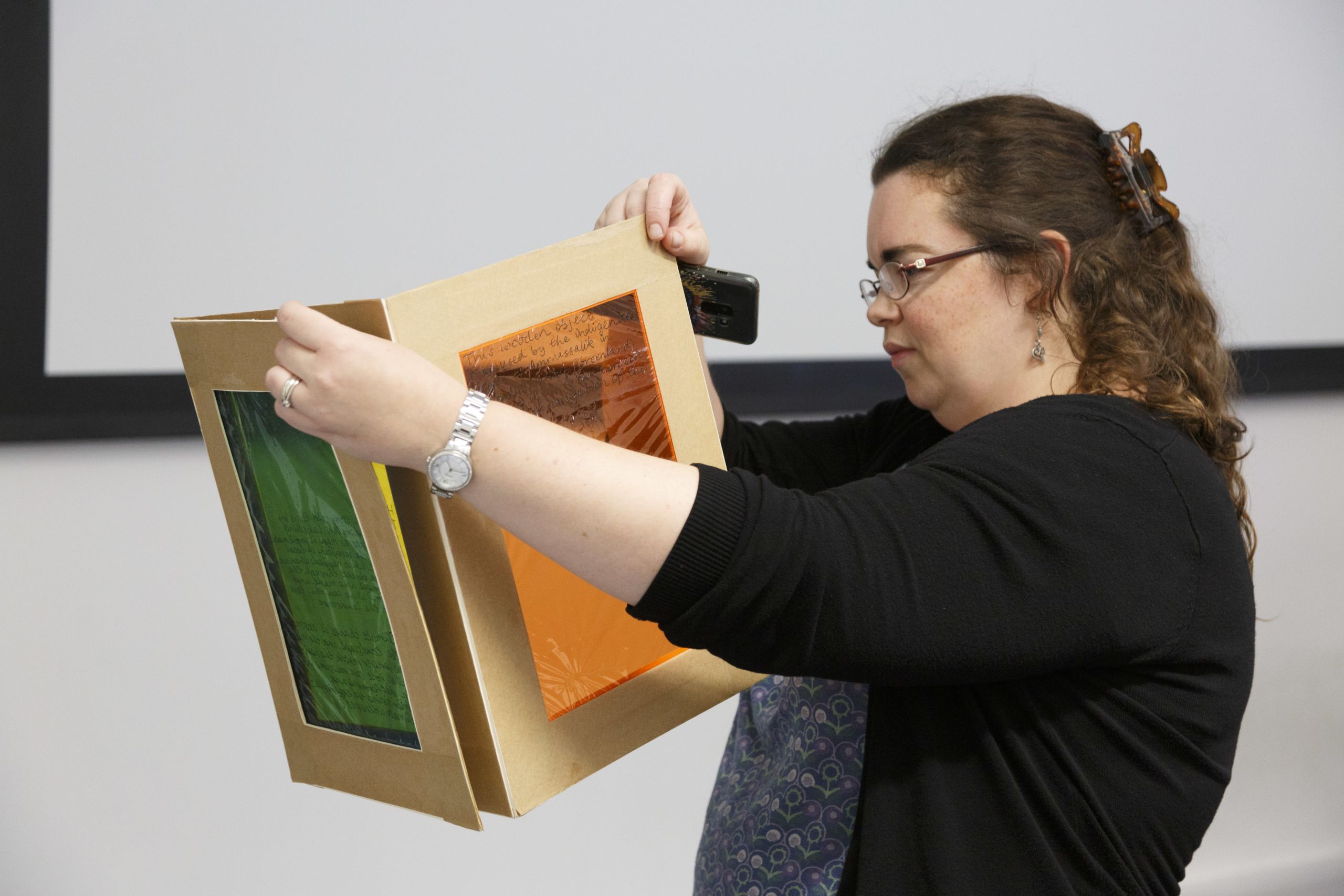
This wooden object is a map used by the indigenous people of Ammassalik in Kalaallit Nunaat (Greenland). Holding it up to the horizon allows for navigation of the landscape.
HOWEVER -
This is the story told to use by western colonisers. Labelling these objects as maps is problematic: it ignores the specificity of local experience. What happens when we view these objects through the eyes of those who made and used them? What can this tell us about the landscape?
Climate change is destroying the landscape, and the maps no longer match the horizon. What role can museums play in platforming and prioritising the experiences of climate witnesses?
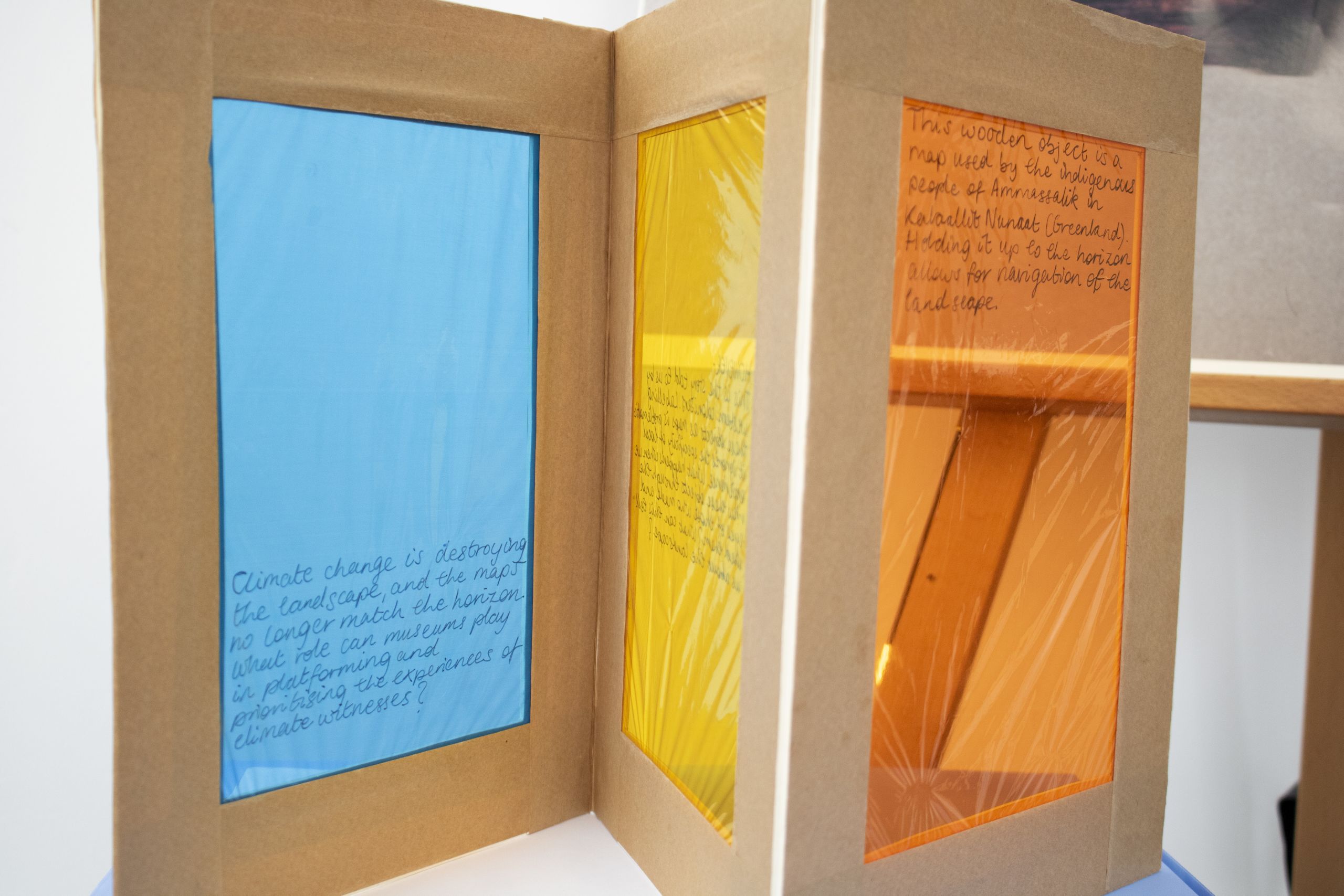
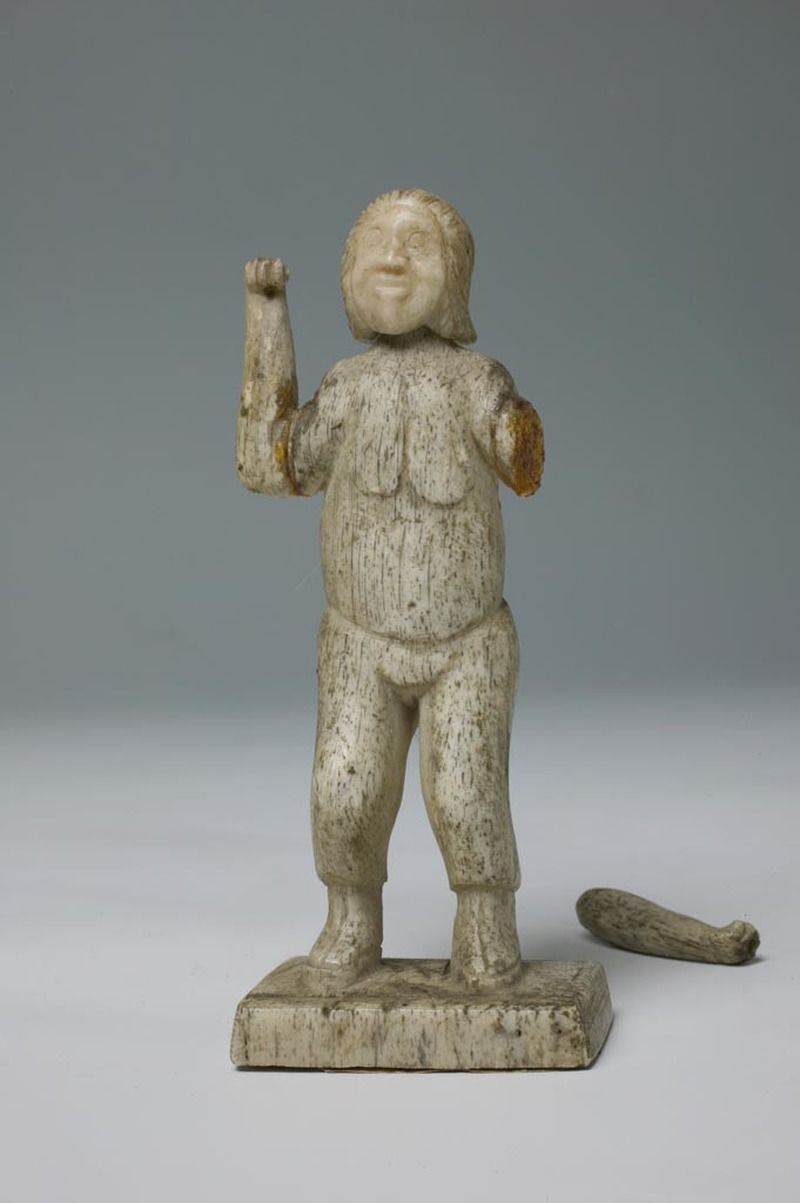
Carving
Kalaallit Nunaat
Artist unknown, date unknown.
Collection: Polar Museum
Reimagined and placed in a card display case:
"?
"Who is telling the story? Whose stories are not being told?
"What are the consequences of mislabelling someone else's experience?
"What can YOU learn from other cultures' interpretation of gender and sexual identity?"
The Museum Remix exhibition was curated by:
Team MAA: Rosa Colaco, David Bellwood, Molly Blacknell, Du Song and Mitch Hubner
Team MOCA: Luis Jimenez, Lizzie Knott, Suzy Rickard, Jack Silvester and Lily Stancliffe
Team Fitzwilliam: Jasmine Brady, Bruna Fernandes, Ana Dias and Lucian Stephenson
Team Polar: Ellie Armstrong, Yu-Chen Lai, Harriet Phillips, Jess Sharpe and Elmira Zadissa
Team Zoology: Kate Howlett, Katie Goldfinch, Harriet Kerridge, Kate O'Neill and Jenny Oxley.

